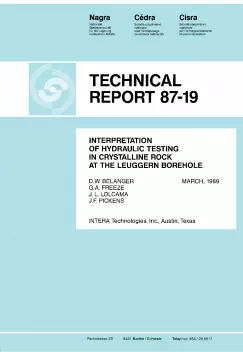
Technical Report NTB 87-19
Interpretation of hydraulic testing in crystalline rock at the Leuggern borehole
This report presents the results of hydrogeologic interpretations of all analyzable single packer, double packer, and H-log tests conducted in the crystalline rock in the Leuggern borehole. Testing of the Muschelkalk at 74.95 to 117.85 m depth is discussed by Schmassmann (1985). Test 217.9S, which is discussed in this report, contains 14.51 m of Buntsandstein and 4.79 m into the top of the crystalline. A discussion of the testing and interpretation methods is presented. Data analysis was performed using the INTERA Graph Theoretic Field Model (GTFM) which permits borehole pressure history and thermally-induced pressure effects to be incorporated into the simulations.
Formation pressures (and corresponding equivalent freshwater heads) were determined for 12 test intervals where testing was performed soon after drilling and the formation had an intermediate to high hydraulic conductivity. The calculated equivalent freshwater heads were between about 363 m asl near the top of the crystalline to about 356 m asl at the bottom of the borehole.
Hydraulic conductivities were estimated for 81 intervals, covering the entire crystalline rock portion of the Leuggern borehole. Interpreted hydraulic conductivities ranged from 2.0E-14 to 1.0E-06 m s-1. Zones of high hydraulic conductivity (greater than 1.0E-08 m s-1) were obtained for six zones corresponding to the following vertical depths: 208 – 267 m, 440 – 485 m, 506 – 566 m, 679 – 704 m, 818 – 851 m, and 1584 – 1632 m.
A base case specific storage of 2.2E-07 m-1 was estimated for the crystalline rock. A sensitivity analysis was conducted for some tests to determine the uncertainty in the best estimate of hydraulic conductivity related to the choice of specific storage. In these cases, specific storage was varied by 1 to 2 orders of magnitude from the base case value.
The measured temperature in the borehole ranged from about 19°C at the top of the crystalline rock to about 66°C at the bottom of the borehole. The temperature increases approximately linearly with depth at a gradient of approximately 3.4°C/100 m.
